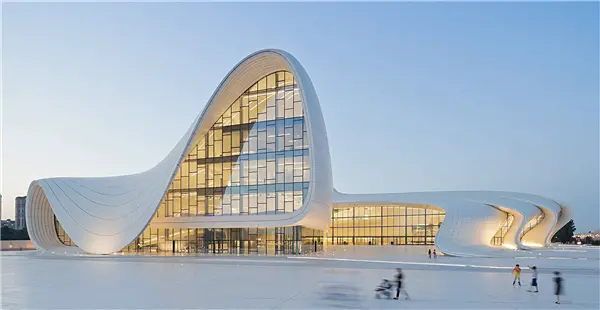The Heydar Aliyev Center in Baku, AzerbaijanPHOTO:IWAN BAAN/ZAHA HADID ARCHITECTS
(THE WALL STREET JOURNAL) Zaha, Hadid,one of a handful of global architects whose involvement on a project instantly conveyed a sense of prestige and cosmopolitan flair, died on Thursday. She was 65 years old.
Her death was confirmed by Zaha Hadid Architects, a practice she established in London in the late 1970s. Ms. Hadid contracted bronchitis earlier this week and died of a sudden heart attack in the early morning during treatment at a Miami hospital, a statement said.
In an era defined by starchitects, Ms. Hadid stood out not for glassy skyscrapers but for her inventive, and often logistically challenging, designs on display in cities around the world. From Leipzig to London, for more than four decades, Ms. Hadid’s work has questioned underlying assumptions of what a building can be. “There are 360 degrees,” she famously said. “So why stick to one?”
In 1993, she completed her first major commission, the Vitra Fire Station in Weil Am Rhein, Germany. From there, she developed a distinctive and powerful design language in projects that included a ski jump in Innsbruck and a tram station in Strasbourg—creations that helped shape her reputation as the doyenne of avant-garde architecture. Her breakout project came in 2003 with the Rosenthal Contemporary Arts Center in Cincinnati, a vast gallery of zig-zagging ramps, praised by critics and described by Ms. Hadid as an “urban carpet.”
High-profile projects completed since then include the coiled, multilayered National Museum of 21st Century Arts in Rome and the sinuous London Aquatic Centre, built for the 2012 Olympic Games. Ms. Hadid was twice the recipient of the U.K.’s RIBA Stirling Prize and has had been awarded the Republic of France’s Commandeur de l’Ordre des Artes et des Lettres and Japan’s Praemium Imperiale. In 2012, she was made a Dame Commander of the Order of the British Empire.
An interior shot from The Rosenthal Contemporary Arts Center in CincinnatiPHOTO:UIG/GETTY IMAGES
“She broke all the possible rules you can break,” said Winka Dubbeldam, a friend of Ms. Hadid’s and the chair and professor of graduate architecture at the University of Pennsylvania School of Design. “She was not a conventional person or architect.”
Born in Baghdad in 1950, she studied mathematics at the American University of Beirut before attending the Architectural Association in London in 1972. In 1979, she started her own practice in London, where she pursued risk-taking designs for which funding was often scarce. Until her biggest award in 2004, Ms. Hadid was perhaps best known for the designs that hadn’t been built—including her 1983 plan for the Peak, a cliff-top resort in Hong Kong, and her sweeping, multilayered Cardiff Bay Opera House from 1994.
In 2004, Ms. Hadid became the first female architect to win the field’s most prestigious award, the Pritzker Architecture Prize—a recognition many felt was overdue. “She was a woman, she was a Muslim, she was an Iraqi, and that doesn’t necessarily play very well everywhere,” said Peter Palumbo, current chairman of the Pritzker Architecture Prize jury. “She had to overcome all that, which she did in grand style.”
Ms. Hadid seemed to take it in stride. “It’s very difficult for a woman to survive in this profession,” she told The Wall Street Journal in an interview in 2000. “But it was also liberating because there were no stereotypes. I didn’t need to become like any other woman architect because there weren’t any.”
 简体中文
简体中文

